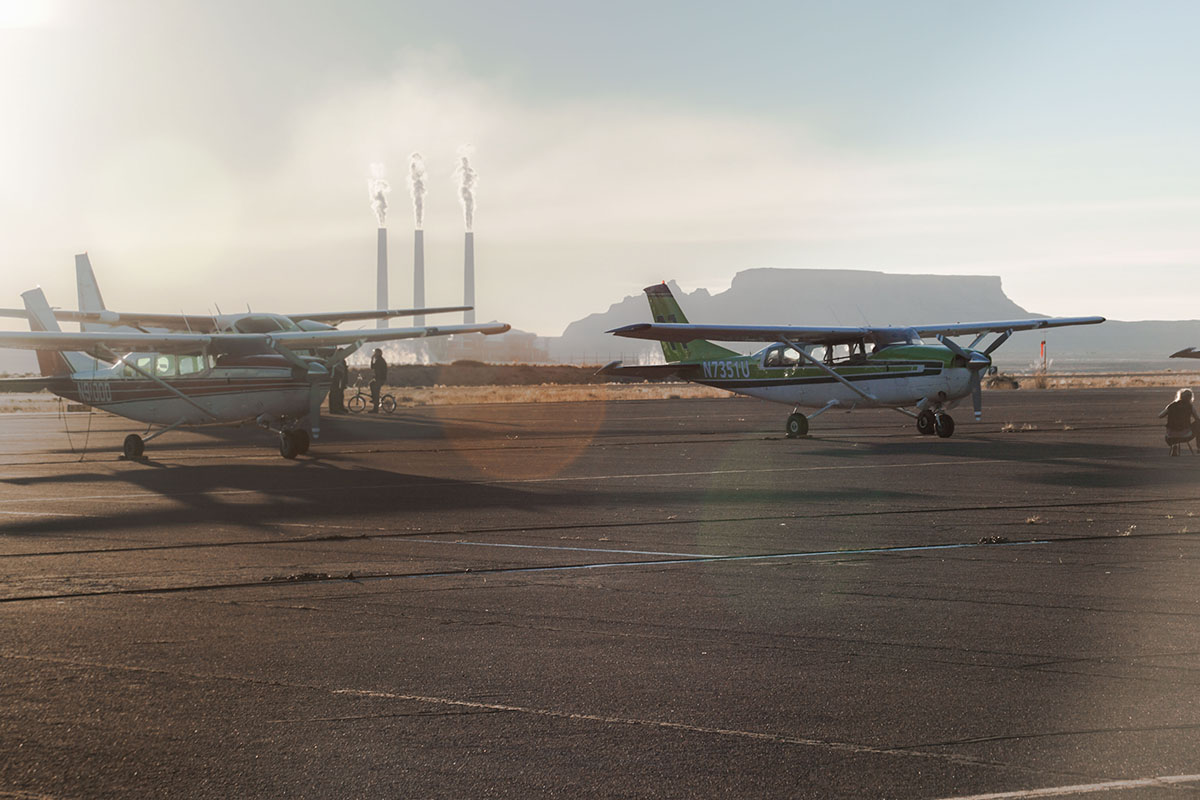
By Katlin Lowe
I was recently given the opportunity to join EcoFlight in their annual student Flight Across America program. EcoFlight aims to raise environmental awareness by flying students, government and organization staff and other leaders in small planes to gain an exciting and aerial perspective of the wild landscape below. Ecoflight believes that by seeing our wild and western terrain from above, we then gain new insights to the interconnections and relationships of our scenery below.
During our trip across the West, my fellow students and I were faced with the topic of “Mega-Drought”and the impacts drought has on our Colorado River watershed. Liza Mitchell from the Roaring Fork Conservancy was our first speaker during the opening night of our trip. She asked each of us the question, “How are you related to the Colorado River watershed?” I responded honestly with some simple answers. Recreation, as most of my Colorado summers are spent down by the river. Municipal use, for drinking water and showering. And also for agriculture; I have a decent sized garden in Avon at 7,400 feet. However, during this trip, I began to realize how much of a deeper connection I had to this watershed.
Within the Colorado River Basin is a growing amount of water demands. Living near the headwaters of the Colorado River watershed, I’m all too familiar with the scarcity of water in Colorado. Eighty percent of Colorado’s water generates from the Western Slope of the Continental Divide, while 80 percent of the state’s population lives on the Eastern Slope; as a result, there is an ever-increasing need for diversions.
We tend to get our water from where it originates and bring it to where we are. Dams and tunnels continually move water through mountains, which have placed an immense amount of pressure on the river system.
That aerial view gave us the opportunity to see our western terrain with a broad scope of the entire region. From our seats in the small plane, we were able to see where the rivers connected, and where bodies of water abruptly collide with manmade structures such as dams and reservoirs. Seeing the western states through this new lens provided me with a new impression of our watershed system.
We flew over the Piceance Basin near Grand Mesa and saw the wild terrain covered with infrastructure. The sheer amount of oil and natural gas pads and dirt roads that cut the land was shocking. This was also my first real glimpse of the impact of natural resource extraction. Oil and gas, uranium, and potash developments have huge impacts to this part of the country. Large holding ponds storing colorful chemicals were strewn throughout this landscape. Neal Clark, a member of the Southern Utah Wilderness Alliance, spoke with us about the mining industry and stressed the many impacts it has on the land. There are 40 million people downstream of the extraction in the Moab area that rely on this water for daily use. However, our need for extraction and development gets in the way.
Landing in Page, Ariz., we saw just how close the Navajo Generating Station – which serves electricity to customers in Arizona, Nevada and California – was to the Colorado River. We saw how the Glen Canyon Dam abruptly stops the Colorado River from flowing free to the southern states. We became frustrated when we saw where the water line used to be in Lake Powell. Our industrial development is no longer working with the amount of water we have. Western society has to move away from the economics approach into a more systems-based, multidisciplinary way of thinking in order to do what’s best for the watershed.

The stunning views flying to the Grand Canyon were suddenly cut off from the amount of uranium mines. We learned that seepage from these same mines is contaminating the groundwater and causing distress for local villages. “Why do we do this?” A member of the Navajo tribe pleaded to us to stop this destruction while asking this simple question. Water is the most definitive resource that we cannot afford to lose. We are seeing a water shortage today because of our over-allocation and misuse of this reserve.
There are many current and proposed destructions happening throughout the West; however, there are also many organizations and conservationists working to save the land, air and water. This was one of the many lasting impressions I have after this trip. We spoke with many amazing leaders within their communities such as Roger Clark (Glen Canyon Institute), Bruce Whitehead (Southwest Water Conservation District), Deon Ben (Navajo community), Jim Pokrandt (Colorado River District), Eric Balkin (Glen Canyon Institute) and many more working to raise awareness about these areas to preserve their beauty. Many bills and proposed monuments happening right now can begin to save the precious amount of fresh water we have left.
So how are you related to the Colorado River watershed? I’m connected to its air. When pollution clouds the atmosphere with toxic chemicals that are carried by the wind, I breathe this. I’m connected to the soil. When bulldozers rip up valuable land to make way for infrastructure, I feel this. I’m connected to the water because it keeps me alive. When the harmful materials from mines seep into our only source of groundwater, I drink this.
Look to your local and state organizations to find out what issues they are tackling. This can be a great way to get involved and be a voice for your community. As Joe Ben from the Navajo tribe said, “Water is life.” Water is our most critical issue and we must work together to find a way to solve it. My job is to now be an advocate for this watershed and I hope that, you too, will join me.
